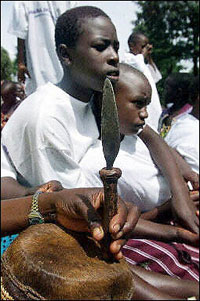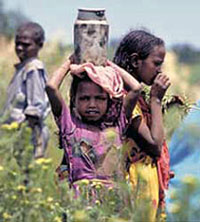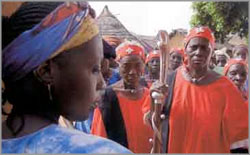|
 |
| Genital mutilation, also referred to as female
circumcision , genital cutting, or excision, is a coming-of-age
ritual that signifies a girl's entry into
womanhood. |
Genital mutilation, also
referred to as female
circumcision , genital cutting, or excision, is a
coming-of-age ritual that signifies a girl's entry into womanhood. It is
accompanied by public celebrations and is often a source of pride for the
girl. For some it also carries religious significance. Usually performed
on girls between the ages of 4 and 12, but also on teenagers, it involves
the partial or total excision of the external female genitalia.
It is performed by a female elder using a razor, knife, or piece of
glass, usually without anesthetic, while several women hold the girl down.
Agonizingly painful, it robs her of sexual pleasure and frequently causes
medical problems, including hemorrhaging, infection, urinary incontinence,
infertility, and complications in childbirth.
** "We have done it, we do it, and we will
continue to do it"

Genital cutting is seen as a way of ensuring that a woman is clean,
chaste, and ready for marriage; uncut women are associated with
promiscuity and lack of social
respectability. Deadening the woman's sexual pleasure is a way of
guaranteeing her virginity and fidelity.
Because it is a valued social rite, most girls are willing to succumb
to the pain and the subsequent health problems. But whether they wish to
be excised or not, the choice is not theirs. Living in a staunchly
patriarchal world, they are dependent on men for social and economic
survival. As a father from the Ivory Coast told the New York Times," If
your daughter has not been excised. . . . No man in the village will marry
her. It is an obligation. We have done it, we do it, and we will continue
to do it. . . . She has no choice. I decide. Her viewpoint is not
important."
** Legislation and media awareness
 In 1994, when a 17-year-old girl from Togo sought asylum in the
United States to escape genital mutilation, few Americans understood the
brutal nature of this ancient and widespread African ritual. Fauziya
Kassindja ran away from home the day she would have been forced to undergo
ritual genital cutting in preparation for an arranged marriage. In 1994, when a 17-year-old girl from Togo sought asylum in the
United States to escape genital mutilation, few Americans understood the
brutal nature of this ancient and widespread African ritual. Fauziya
Kassindja ran away from home the day she would have been forced to undergo
ritual genital cutting in preparation for an arranged marriage.
She eventually made her way to the United States, but instead of
granting her asylum ,
immigration officials arrested her for illegal entry and sent her to
prison for a year and a half, where she was sometimes shackled and placed
in solitary confinement. Although human rights advocates sought her
release, the courts found her story "not credible." Only when the media
exposed her plight was she freed.
Kassindja's case became a lightning rod for growing legislative and
media attention, awakening the nation to a dangerous and painful practice
that is the social norm for women in many central African
countries. Senator Harry Reid fought for a ban although "all my
staff advised me to stay away from it," considering it a squeamish subject
for a male politician.
When Stephanie Walsh was awarded the Pulitzer Prize in 1996 for her
photographs of a genital mutilation rite in Kenya, the inhumanity of the
procedure was exposed to the general public, helping to legitimize a
subject that many found uncomfortable to discuss. ** An
ancient tradition resists reform
For the past ten to fifteen years, France has criminally prosecuted immigrant parents who have had
their daughters excised, and in October 1996 the U.S. Congress outlawed
female genital mutilation in this country. The U.N. announced a global
campaign in 1997 to eradicate the practice, and a growing number of
refugee, women's, and human rights organizations in Africa and around the
world have called for its prohibition. But progress has been slow.
Western reform movements are sometimes counterproductive, with Africans
resisting the dictates of patronizing outsiders. Outlawing the practice
had already been attempted by colonial governments in Africa during the
first half of the century, provoking only resistance and protests.
The World Health Organization estimates it will take a minimum of ten
years to reduce the prevalence of genital mutilation, and three
generations to eradicate it. It will take time to transform awareness of a
firmly entrenched ritual that is valued by the local culture but
considered dangerous and demeaning by outsiders.
** Countries practicing genital
mutilation
Genital mutilation is practiced in 28 countries in central Africa,
ranging from Somalia in the east coast and stretching westward to Senegal
on the Atlantic. The rite is believed to have originated more than two
thousand years ago in Egypt or the Horn of Africa (what is now Eritrea,
Djibouti, Ethiopia, and Somalia). The World Health Organization estimates
that more than 130 million women have undergone the procedure. Although it
is most often associated with Islam, it is also practiced by Christians,
adherents to traditional African religions, and one Jewish
sect.
**
Background
割禮這一習(xí)俗源于猶太教,有2000多年的歷史。在猶太人中間,割禮實(shí)際上是履行與上帝之立約、確定猶太人身份、進(jìn)入婚姻許可范圍的一種標(biāo)志。現(xiàn)在,割禮不再局限于猶太人,在非洲,50多個(gè)國家中有30多個(gè)在不同范圍內(nèi)實(shí)行割禮。
非洲割禮的習(xí)俗已有4000多年歷史。據(jù)聯(lián)合國有關(guān)資料透露,目前,受過割禮的女子已有1.3億人之多,現(xiàn)在平均每天還有約6000名女孩經(jīng)受刀割之苦。在非洲,女子行割禮十分普遍。一些地區(qū)通行割禮,另一些地區(qū),如埃及和肯尼亞半數(shù)女孩須行割禮。在塞內(nèi)加爾和坦桑尼亞,15%的女孩要行割禮。
世界衛(wèi)生組織2002年的一份報(bào)告表明,世界每年大約有200萬女孩面臨被實(shí)施割禮的危險(xiǎn)。割禮師骯臟的"手術(shù)刀"每年都會(huì)造成多起事故,包括傷口潰瘍、破傷風(fēng)、大出血、傳播艾滋病乃至死亡,這對(duì)婦女特別是少女的身心造成了嚴(yán)重傷害。
日前,肯尼亞總統(tǒng)莫伊代表政府首次就女子割禮問題表明立場(chǎng)稱,女子割禮是陳規(guī)陋俗,應(yīng)該予以擯棄。莫伊呼吁人們像同艾滋病作斗爭一樣來鏟除這種陳規(guī)陋俗。據(jù)新華社報(bào)道,此前,坦桑尼亞、多哥、塞內(nèi)加爾和科特迪瓦等國已通過立法禁止女子割禮,試圖鏟除這種陳規(guī)陋俗。
(Agencies) |
